5 March 1999
On Board the Department of Conservation Vessel TOHORA
South Bay, Kaikoura, New Zealand
Listening to the Whales - Part Three

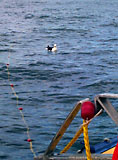 With the hydrophones in the water and the
computer recording without any problem, we all
settled in for a long day. The boat would slowly
drift with the wind and currents, birds would fly
by to investigate and one or two even thought
that we were interesting enough to land in the water next to
us and drift along with the boat.
An occasional porpoise
would swim by, take a look at what we were doing
and head off looking for something more
appealing. And then, coming towards us with
deliberate speed, was that very recognizable
triangular dorsal fin that could only be one
thing - a shark. Keith and Bernard said that
blue sharks were fairly common in these waters
and that most likely this was one of those. Like
the porpoise, the shark decided that we were
probably not something worth eating and continued
on his way. Sitting here on the bow of what was
essentially a big balloon (remember, this was an
inflatable boat), i couldn't help but remember a
previous experience that I had with a shark and a
small boat. Thankfully, this time around the
only thing that came between us were curious
glances.
With the hydrophones in the water and the
computer recording without any problem, we all
settled in for a long day. The boat would slowly
drift with the wind and currents, birds would fly
by to investigate and one or two even thought
that we were interesting enough to land in the water next to
us and drift along with the boat.
An occasional porpoise
would swim by, take a look at what we were doing
and head off looking for something more
appealing. And then, coming towards us with
deliberate speed, was that very recognizable
triangular dorsal fin that could only be one
thing - a shark. Keith and Bernard said that
blue sharks were fairly common in these waters
and that most likely this was one of those. Like
the porpoise, the shark decided that we were
probably not something worth eating and continued
on his way. Sitting here on the bow of what was
essentially a big balloon (remember, this was an
inflatable boat), i couldn't help but remember a
previous experience that I had with a shark and a
small boat. Thankfully, this time around the
only thing that came between us were curious
glances.
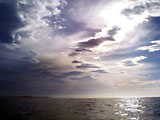 The day wore on. We pulled the arrays a few
times and moved to different locations to try and
get closer to the whales. By mid-afternoon we
had recorded quite a few complete dives which
made Bernard quite happy, when Keith who had been
monitoring the radio, heard that the weather was
beginning to deteriorate fairly rapidly to our
north and that it was heading our way.
The day wore on. We pulled the arrays a few
times and moved to different locations to try and
get closer to the whales. By mid-afternoon we
had recorded quite a few complete dives which
made Bernard quite happy, when Keith who had been
monitoring the radio, heard that the weather was
beginning to deteriorate fairly rapidly to our
north and that it was heading our way.
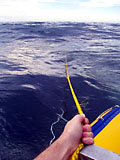
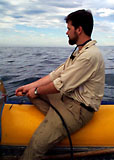 With the weather closing in on us, we began to
haul in the arrays with as much speed
as we could, taking care not to damage any of the
delicate connectors or hydrophones. Retrieving
the hundreds of meters of line was certainly a
two person job - me hauling in the line and
getting thoroughly soaked in the process and
Bernard coiling the line and spooling it back
onto the drum. The single hydrophone line was
relatively light and didn't take very much
effort. However, as Bernard said to me when we
started "Gene, today you are going to have the
complete experience", I knew there was
more it it than this. With the first line
carefully stowed, Bernard said "OK, why don't you
haul up the second one". By the smiles on
Bernard and Keith's faces I should have guessed
that I was in for something.
With the weather closing in on us, we began to
haul in the arrays with as much speed
as we could, taking care not to damage any of the
delicate connectors or hydrophones. Retrieving
the hundreds of meters of line was certainly a
two person job - me hauling in the line and
getting thoroughly soaked in the process and
Bernard coiling the line and spooling it back
onto the drum. The single hydrophone line was
relatively light and didn't take very much
effort. However, as Bernard said to me when we
started "Gene, today you are going to have the
complete experience", I knew there was
more it it than this. With the first line
carefully stowed, Bernard said "OK, why don't you
haul up the second one". By the smiles on
Bernard and Keith's faces I should have guessed
that I was in for something.
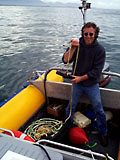 Remember that railway hammer
Bernard tied to the end of 120 meters of very
thick and very heavy cable? Well, it was now my
turn to haul it back into the boat. The first few minutes
were pretty easy but as more and more of the line came in,
or perhaps as my arms grew more tired, I could swear that
somebody or something had grabbed hold of the other
end of the line and was pulling down every time I tried to pull it up.
With Bernard and Keith providing encouragement, I finally
managed to get the last of the line on board and was very
happy to finally hold that weight in my hand.
Remember that railway hammer
Bernard tied to the end of 120 meters of very
thick and very heavy cable? Well, it was now my
turn to haul it back into the boat. The first few minutes
were pretty easy but as more and more of the line came in,
or perhaps as my arms grew more tired, I could swear that
somebody or something had grabbed hold of the other
end of the line and was pulling down every time I tried to pull it up.
With Bernard and Keith providing encouragement, I finally
managed to get the last of the line on board and was very
happy to finally hold that weight in my hand.
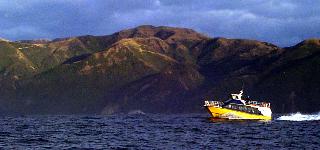 With all the gear finally stowed, Keith fired up the engine and along with the rest of the boats that were in the area,
we started to head back towards the dock as fast as we could
in hopes of beating the weather. Just as we got underway
I heard a loud, almost chirping sound. To my complete surprise,
Keith reached into his pocket and
pulled out a cellular phone.
With all the gear finally stowed, Keith fired up the engine and along with the rest of the boats that were in the area,
we started to head back towards the dock as fast as we could
in hopes of beating the weather. Just as we got underway
I heard a loud, almost chirping sound. To my complete surprise,
Keith reached into his pocket and
pulled out a cellular phone.
I couldn't hear a thing because of the roar of the engine, so
imagine my surprise when he turned around, handed me the phone
and said "it's for you, Mate".
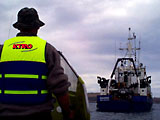 I have had many experiences in my life but up until that point
I had never actually used a cell phone. So here I am,
racing across the waters of South Bay, New Zealand
having my very first cell phone conversation. And who was
at the other end of the line? Clyde - on his cell phone! He called to say
that he had just spoken to the KAHAROA and that they
were planning on doing the first dive in Kaikoura late this afternoon
and that I should meet him at the boat - IMMEDIATELY.
Sometimes there really is truth in the saying "being in the
right place at the right time" because just as we ended our
conversation, Keith was coming up alongside the Kaharoa.
I have had many experiences in my life but up until that point
I had never actually used a cell phone. So here I am,
racing across the waters of South Bay, New Zealand
having my very first cell phone conversation. And who was
at the other end of the line? Clyde - on his cell phone! He called to say
that he had just spoken to the KAHAROA and that they
were planning on doing the first dive in Kaikoura late this afternoon
and that I should meet him at the boat - IMMEDIATELY.
Sometimes there really is truth in the saying "being in the
right place at the right time" because just as we ended our
conversation, Keith was coming up alongside the Kaharoa.
best regards,
gene
<-- Return to Part 2 or continue on to the Next Journal -->

 With the hydrophones in the water and the
computer recording without any problem, we all
settled in for a long day. The boat would slowly
drift with the wind and currents, birds would fly
by to investigate and one or two even thought
that we were interesting enough to land in the water next to
us and drift along with the boat.
An occasional porpoise
would swim by, take a look at what we were doing
and head off looking for something more
appealing. And then, coming towards us with
deliberate speed, was that very recognizable
triangular dorsal fin that could only be one
thing - a shark. Keith and Bernard said that
blue sharks were fairly common in these waters
and that most likely this was one of those. Like
the porpoise, the shark decided that we were
probably not something worth eating and continued
on his way. Sitting here on the bow of what was
essentially a big balloon (remember, this was an
inflatable boat), i couldn't help but remember a
previous experience that I had with a shark and a
small boat. Thankfully, this time around the
only thing that came between us were curious
glances.
With the hydrophones in the water and the
computer recording without any problem, we all
settled in for a long day. The boat would slowly
drift with the wind and currents, birds would fly
by to investigate and one or two even thought
that we were interesting enough to land in the water next to
us and drift along with the boat.
An occasional porpoise
would swim by, take a look at what we were doing
and head off looking for something more
appealing. And then, coming towards us with
deliberate speed, was that very recognizable
triangular dorsal fin that could only be one
thing - a shark. Keith and Bernard said that
blue sharks were fairly common in these waters
and that most likely this was one of those. Like
the porpoise, the shark decided that we were
probably not something worth eating and continued
on his way. Sitting here on the bow of what was
essentially a big balloon (remember, this was an
inflatable boat), i couldn't help but remember a
previous experience that I had with a shark and a
small boat. Thankfully, this time around the
only thing that came between us were curious
glances.





